South Korea Patients Test Positive Again
Notice: This article was published earlier in the COVID-19 pandemic, based on the latest published data at this fourth dimension. You can notice the well-nigh up-to-date data for all countries in our Coronavirus Data Explorer.
Introduction
Due south Korea's response to COVID-19 has been impressive. Building on its experience handling Middle East respiratory syndrome (MERS), Due south Korea was able to flatten the epidemic bend quickly without closing businesses, issuing stay-at-dwelling house orders, or implementing many of the stricter measures adopted by other high-income countries until late 2020. Information technology accomplished this success by developing clear guidelines for the public, conducting comprehensive testing and contact tracing, and supporting people in quarantine to brand compliance easier. The country successfully managed outbreaks in March and August and gradually gained control of a larger, more dispersed outbreak in Dec 2020. Overall, Republic of korea has shown success across three phases of the epidemic preparedness and response framework: detection, containment, and treatment.
- Discover: Southward Korea built innovative, high-chapters screening facilities and worked closely with the individual sector to ensure an adequate supply of tests from the onset of the pandemic. The country maintains approximately 600 screening and testing centers and 150 diagnostic laboratories, with capacity reaching 110,000 tests as of Nov 2020.
- Comprise: Republic of korea isolated infected patients, increased compliance by supporting those in quarantine, and traced contacts with unusual thoroughness. Hundreds of epidemiological intelligence officers were deployed for these tracing efforts and empowered to use a wide variety of information sources, including credit card transactions and closed-circuit television footage.
- Treat: The health system surged to run across demand, particularly in Daegu, the site of a big cluster of infections in March 2020. An additional 2,400 health workers were recruited in Daegu alone. Across the state, the government restructured the hospital system, built temporary hospitals to increase capacity, and addressed shortages of personal protective equipment (PPE) through centralized authorities purchasing.
South Korea's potent enabling environment positioned the government to act chop-chop and effectively. After its flawed response to a MERS outbreak in 2015, the government fabricated 48 reforms to heave public health emergency preparedness and response. In addition, a well-operation national health insurance system, ample human being resources and infrastructure, and constructive relationships betwixt fundamental institutions—such as the president'due south office, the Ministries of Health, Didactics, and Foreign Affairs, and the Korean Centers for Illness Control and Prevention, which was renamed the Korea Disease Control and Prevention Agency (KDCA), during the pandemic—enabled an extraordinarily decisive response to the pandemic.
Context
Country Overview
Since the 1960s, South korea's economy has grown at a remarkable pace, and information technology is currently the 12th largest in the globe.2 Health outcomes have improved alongside economic progress. South Korea put social health insurance in place in the 1970s, achieved universal health care coverage in 1989, and transitioned to a unmarried-payer system in 2004.iii
South Korea's health system is centered on hospital-based care. The number of hospital beds per capita, 12.3 beds per 1,000 population, is ii times higher than the average in Organization of Economic Cooperation and Development (OECD) countries.4 The state excels not only in hospital capacity just besides in interactions with doctors, with an OECD-leading sixteen.6 consultations annually per capita.5 Although some critics suggest that Republic of korea'due south wellness organization is overly dependent on secondary or tertiary facilities instead of primary facilities, this extra capacity enabled hospitals to answer chop-chop to COVID-xix without sacrificing treat not-COVID-19 patients.6
Despite its robust health system, Republic of korea struggled to respond appropriately to the 2015 outbreak of MERS, which resulted in nearly 17,000 suspected cases and 38 deaths. During the vi months of that outbreak, Koreans lived in fear, and the government lost an estimated US$ii.6 billion in tourism revenue while spending almost US$1 billion on diagnosis, treatment, and other parts of its response.7
After MERS, the country made a total of 48 reforms to improve pandemic preparedness and response, including more infection control staff and isolation units, expanded outbreak simulations and PPE training, and community-based collaboration between medical centers and local governments.viii When COVID-19 struck, the painful memory of MERS inspired an early and ambitious government response—and a willingness among people to wear masks, cooperate with contract tracers, and otherwise listen to public wellness officials. For case, wearing a mask in public spaces, already mutual because of air pollution, became a social norm early in the pandemic.9 A poll showed that more people adhered to public prevention protocols during the COVID-19 outbreak than during the MERS outbreak.10
Outbreak Timeline
Southward Korea was one of the kickoff countries to experience a COVID-19 outbreak, with its first instance, imported from Wuhan, Mainland china, reported on January xx, 2020 (see Figure one). The regime activated the Fundamental Disaster and Prophylactic Countermeasures Headquarters within days, and it has met daily since and then, with the prime minister attention at to the lowest degree three times a week.11
The number of confirmed cases ranged from nothing to two per day for the first month of the outbreak, until a cluster was identified in Daegu, a urban center of about 2.five million, starting at 15 cases on February xix. The cluster originated from the individual known as patient 31, who traveled effectually the cities of Daegu (including the Shincheonji Church of Jesus) and Seoul before her diagnosis.12 Thereafter, daily confirmed cases rose rapidly and reached a summit of 909 on Feb 29.
Subsequently this meridian, the number of new cases brutal chop-chop in the following ii weeks until it hovered below 200 daily confirmed cases past March 12. Daily cases continued to decline steadily to nearly zero, although there was a minor resurgence in mid-May (about 30 cases per mean solar day) as the country started to reopen.13
COVID-19 Timeline
New cases per twenty-four hours (vii day rolling average)
On May 6, the national mandates on social distancing were relaxed in favor of softer guidelines. Schools began property in-person classes on May 20, which was relatively early on. Past June, simply xx countries had reopened schools—and 4 had never closed them down.fourteen The render to in-person classes in South Korea was staggered by course and completed by June 8, 2020,15 with density restrictions (eastward.thousand., staggering days on which students attended in person) in areas of higher customs transmission.xvi Studies conducted over the summer found that reopening schools had a limited bear on on the development of new disease clusters.17 In the semester starting September 2020, schools were given more autonomy over opening procedures and lighter capacity restraints, with guidelines fix by the Ministry of Education based on the level of social distancing in effect.18 Throughout the closure and reopening process, government support for childcare, internet, and technology was provided to families in demand.

In mid-Baronial, another spike in cases led to a summit average example count of 343.nine on August 28.20 Like the Daegu outbreak, this outbreak was also linked to a religious group, the Sarang Jeil Church in Seoul. In response, Seoul reinstated its Level 2 restrictions (out of three levels), which includes limiting indoor gatherings to l people and outdoor gatherings to 100. It also collected the names of approximately four,000 church building members and tested nearly one-half of those, although contact tracing efforts were resisted past the church.21 Level 2 restrictions were reinstated on Baronial 23, and by September twenty, daily cases had fallen below 100.
In September 2020, the Korean CDC, previously under the Ministry of Health and Welfare, transitioned to a stand-lonely agency called the Korea Disease Control and Prevention Bureau (KDCA), with increased staffing. KDCA releases daily reports that not only outline the raw numbers (east.g., cases, deaths, patients by severity), but also identify the location and instance counts by different clusters and remaining health system capacity such as bed counts in intense care units.22
Daily cases hovered around 100 in mid-November, when Southward Korea began to experience its third significant outbreak, with daily case counts that peaked at over i,000 before decreasing in Jan 2021.23
Notice
KDCA received viral specimens from China to begin developing diagnostic tools even before the first case was confirmed in South korea. As before long as the first case was reported, Republic of korea turned its focus toward preparing for large-scale testing. Many biotechnology companies sprang up in the years between MERS and COVID-xix,24 enabling the development of public-private partnerships and scaled-up testing for astringent astute respiratory syndrome coronavirus 2 (SARS-CoV-2), the virus that causes COVID-19.
On January 27, 2020, a week after the first COVID-19 instance in South korea, KDCA directed private companies to produce a diagnostic reagent.25 Inside two weeks of the first case, thousands of test kits were shipped daily, with the number reaching upwardly to 100,000 kits per day in March.26 Past Apr 24, 118 institutions were able to run an boilerplate of fifteen,000 tests (and up to 20,000) per day. The number of institutions running tests connected to climb gradually, reaching 146 past August.27 After, testing capacity increased 600 percentage, reaching 110,000 per 24-hour interval past Nov 2020.
After testing capacity was expanded, the focus shifted to screening. To prevent infected people from inbound hospitals, for example, COVID-nineteen screening clinics were set up outside entrances. Those flagged based on their symptoms or responses to screening questions were tested and told to return abode and cocky-quarantine while they waited for results, whereas those who were considered low adventure received a mean solar day entrance laissez passer. Screening stations were set up up in diverse strategic locations, including at Incheon International Airport. By September 22, there were 599 screening stations, including 48 drive-through centers. To encourage full testing among migrant worker communities, where several clusters emerged, the government announced that it no longer required health workers to report known undocumented residents.28
During the surge of cases in Daegu in February 2020, health officials opened 600 screening centers using innovative approaches to increase capacity.29 For case, bulldoze-through testing centers nerveless three times as many samples as conventional ones, while removing the need for negative pressure rooms that prevented contaminated air from escaping into uncontaminated areas.thirty Meanwhile, phone berth–style stations enabled wellness care workers to evaluate and exam people without coming into direct contact with them. First, workers stood outside negative pressure level booths wearing PPE. Somewhen, they shifted to positive pressure booths, which minimized the need for PPE and thereby prevented fatigue.31 Past tardily March, the land had performed over 300,000 tests, equal to a rate more than than forty times higher per capita than in the Usa at that time.
Since March fifteen, the test positivity rate has been beneath 2 percent, and from April half dozen to Baronial 15, information technology was 1 pct or lower. During the second spike in Baronial, the positivity rate peaked at 2.5 per centum, and it reached 3.3 percent during the December surge, both well beneath the World Wellness Organization benchmark of 10 percent test positivity for adequate testing levels.32
Comprise
Travel Restrictions
In tardily January 2020, South Korea instituted special entry procedures for travelers coming from Wuhan. Procedures initially included designated entry lines and questionnaires and later on expanded to include temperature checks, testing all travelers at the border, and mandatory quarantines monitored for fourteen days. (Travelers without Korean residency are provided facilities for cocky-quarantine but must pay for the cost of their stay.) This policy of tracing and quarantining, rather than restricting entry, is in line with recommendations from the WHO, whereas edge closures are not.33
As case counts increased globally in the summer and autumn of 2020, Republic of korea tightened travel restrictions and equally of Oct 2020, requires visas for nearly all foreign nationals. It suspended visa-waiver countries and visa-costless countries, with some exceptions (eastward.g., flight attendants). Visa applicants are required to submit forms about their wellness status and prove symptom-free certification from a medical professional. Overall, visitors to South Korea decreased by 81 per centum year-over-yr.34
Isolation and Quarantine
In the early months of the pandemic, the South Korean government transformed public facilities and retreat centers owned past private corporations into temporary isolation wards. It did this for two reasons: to care for COVID-19 patients while preventing transmission within households, and to salvage hospitals of bed shortages. Health care workers regularly monitored and quarantined clinically stable patients who did not crave inpatient treatment.35
In Daegu, the site of the first cluster, fifteen community handling centers, including several in dormitories for training institutes of private companies such as Samsung and LG, admitted 3,033 people between March 3 and March 26, 2020. Wellness professionals monitored the centers and patients reported their symptoms regularly past a smartphone application or by phone. The facilities were equipped with pulse oximeters, 10-ray machines, and RT-PCR tests for SARS-CoV-2. Merely 81 of 3,033 (2.67 percent) cases were transferred to a hospital for higher-level care.36
South korea's quarantine policies are strict simply supportive. People who accept been in contact with a confirmed example, traveled internationally, or suspect they might exist infected are required to self-quarantine. Those in quarantine are required to employ the Self-Quarantine Prophylactic Protection app for fourteen days. Case officers monitor the app, including location tracking, to identify when people break quarantine. Violators are required to clothing "safety bands," electronic wristbands that connect to the app and alert instance officers if they are not in the aforementioned location as their mobile devices. The fine for violating cocky-quarantine is heavy: U.s.a.$8,217.37
At the same time, case officers provide support to make quarantine easier. Twice daily they bank check in with those who are cocky-quarantining, to deliver food and toiletries and offer psychological counseling and video-streaming services for entertainment.38
South Korea has maintained a focus on mental wellness throughout the pandemic, creating hotlines and recordings for those in isolation as early as January and maintaining a national psychological support team.39
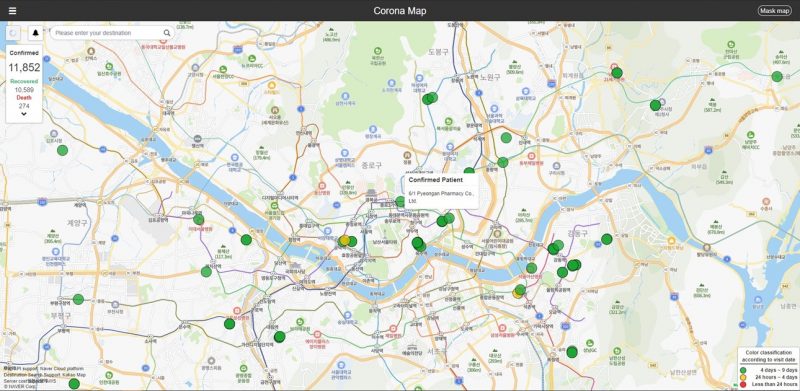
Contact Tracing
South korea took an aggressive approach to contact tracing early in the outbreak. Start, they scaled upwardly their network of contact tracers. 2d, they gave these workers access to data beyond what they might be able to larn from a typical patient interview. Third, they used public communications to empower citizens to help the wellness system with contact tracing.
Republic of korea expanded its usual workforce of Epidemic Intelligence Service (EIS) officers by quickly grooming staff at approximately 250 local public health centers, hiring 300 private epidemiologists, and leveraging staff at 11 nongovernmental organizations that train and support EIS officers. This multilevel arroyo was constructive, with the veteran EIS officers conducting the more difficult investigations in large clusters, and wellness facilities and temporary staff handling smaller clusters including families. These efforts led to earlier example detection, kept the charge per unit of new infections low, and potentially reduced estimated mortality rates by preventing hospital overcrowding and infections among loftier-run a risk populations.41
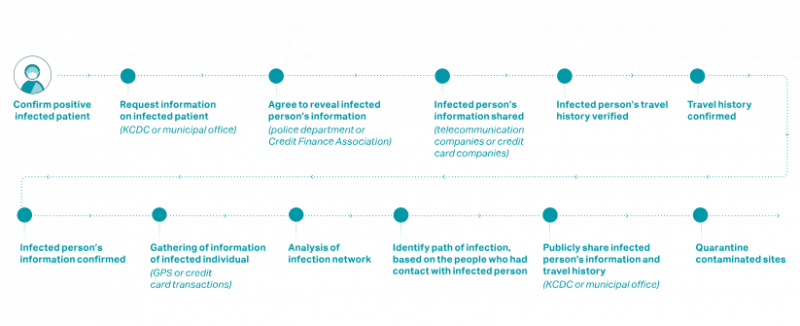
The work of the EIS officers was further facilitated by legal changes following the 2015 MERS outbreak. When necessary, the officers were permitted to draw on iv major types of information in addition to patient and doc interviews:
- Facility visit records, including pharmacies and medical facilities
- Cellular GPS data from jail cell phones
- Credit card transaction logs
- Closed-circuit television
This information was combined with interviews and cross-checked with other information to trace contacts and take appropriate containment measures.43 (see figure beneath)
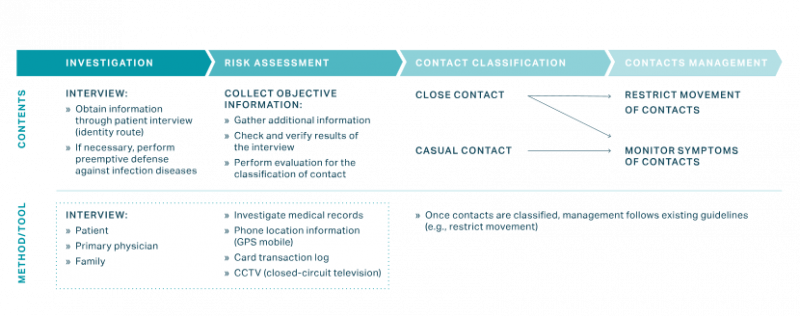
On June x, 2020, the country introduced an additional system called KI-Pass to aid contact tracing efforts afterward outbreaks at several high-take a chance locations. The system introduces QR codes at loftier-traffic facilities like bars and gyms to replace transmission sign-in sheets.45 To answer to public worry about data utilise and privacy, the government instituted additional data protections, including automatically deleting data later on 14 days.46
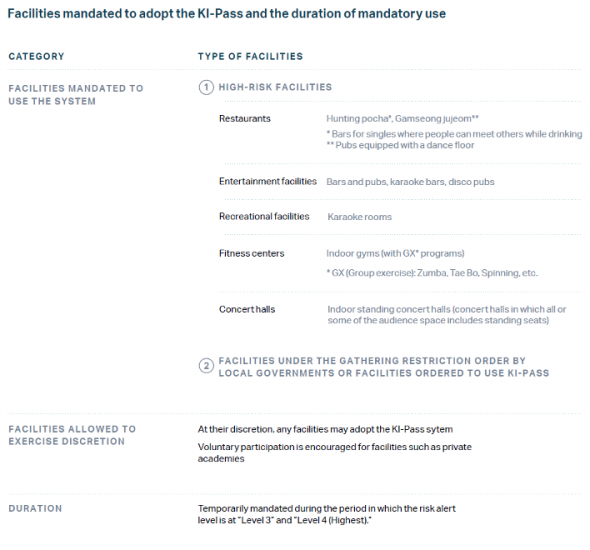
South Korea encourages compliance with containment efforts by developing apps that nerveless relevant data, which eases the brunt on EIS officers and made information technology possible for them to cope with the high volume of investigations. Patient trajectories are fabricated public to enable citizens to track their own movements compared with those of suspected cases. Traveler information is shared with health facilities and pharmacies to facilitate prompt identification of cases and contacts.48
Social Distancing
Korea has a three-tiered social distancing system with half levels (i.eastward., Level 1, Level ane.5, then on through Level 3), as well equally a "distancing in daily life" strategy, designed to be the nigh sustainable level of restriction. These levels are adjusted based on metrics including the number of cases and rate of change.49
In May and June, after the beginning implementation of the "distancing in daily life" strategy, multiple outbreaks occurred in the Seoul area, with clusters from bars and warehouses. As a result, Seoul resumed more strict distancing guidelines until daily instance counts were beneath x. During the 2d spike in August, the entire state moved up to Level ii. These restrictions were eased in virtually of the country on October 1250 only tightened again to Level 2 in Nov and Level 2.5 in Seoul in December as infections among asymptomatic young people increased.
Throughout the pandemic, information on proper mask-wearing and distancing was widely shared, and the government worked to find sources of misinformation. When misinformation was identified, the Korea Communications Standards Committee addressed the effect with cooperation from major websites like Google and Facebook.51 In October, Korea amended its Infectious Disease Control and Prevention Act to introduce mandatory mask-wearing, enforceable by fines of up to 100,000 Korean won (KRW), approximately US$90.52
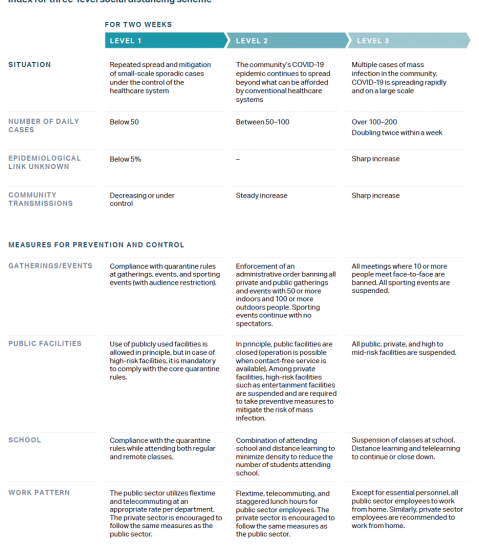
Care for
During a shortage of hospital beds in the epicenter of Daegu, wellness officials adult a triage organization using a brief severity scoring organisation to classify patient illnesses equally mild, moderate, severe, or disquisitional. Mildly ill patients were sent to customs treatment centers where they were closely monitored, moderately ill patients were sent to community hospitals, and severely or critically ill patients were hospitalized at tertiary hospitals equipped to provide intensive intendance.54
Using portable negative pressure level devices, the government was able to speedily expand the supply of temporary airborne infection isolation rooms. In Daegu, officials created almost 400 additional negative pressure level beds during the crisis.55
Daegu officials besides recruited about 2,400 additional health care workers who were spread out among screening clinics, communicable diseases hospitals, and community handling centers. In addition, 327 physicians volunteered without pay to participate in the public wellness response, with thirty volunteering for the centralized COVID-xix response team and 260 volunteering for phone triage centers.56
As with many cities around the globe during the COVID-19 pandemic, Daegu faced a shortage of PPE, a critical event that was escalated to the national government. Initially, the authorities limited the export of masks and penalized hoarding among retailers, merely in mid-Feb, emergency measures doubled the production of masks in South korea to an average of 10 one thousand thousand per day by March.57
The government intervened in early March to purchase 80 percent of the mask supply from Korean manufacturers, fully ban exports, ready a price limit on mask sales, and limit the number of masks sold weekly through retailers. Moreover, the authorities prioritized the distribution of masks to medical facilities. These interventions provided relief and averted farther shortages, without forcing hospitals to issue policies nigh reusing PPE.58 As the mask supply stabilized, the government relaxed sales limits to three masks in April and 10 in June, and eliminated specific purchasing days. This policy was enforced by the development of a shared database that logged purchases beyond markets, post offices, and pharmacies.59
Afterwards the Daegu surge, Republic of korea took a serial of steps to manage capacity in the wellness organization. The Primal Disaster and Safety Countermeasure committee restructured the wellness intendance system to course six regional clusters (instead of 17 country and city jurisdictions) to make information technology easier to transfer patients between facilities and manage chapters.60 Currently, a variation of the severity scoring system start used in Daegu is in use nationwide, with four dissimilar categories: asymptomatic, mild, moderate, or severe. Asymptomatic and mild cases are placed in one of five residential treatment centers instead of hospitals.
Every bit of September 22, 2020, in improver to the 198 beds that compose the National Designated Isolation Unit, 43 hospitals with 4,075 hospital beds were designated Infectious disease Hospitals and dedicated to COVID-19 treatment.Similarly, 323 hospitals were designated National Safe Hospitals for people seeking non-COVID-19 treatment. Each of these hospitals has separate areas for those with respiratory symptoms to be evaluated.61
Health and Economic Bear on
So far, disruptions of the health system have been limited. Given the relatively depression incidence of COVID-19 and rapid control of major outbreaks through the fall season, hospitals were not overwhelmed. In addition, South korea'southward policy of designating COVID-19 and non-COVID-19 hospitals helped maintain the normal functioning of the health system for all needs.
Economically, South korea is expected to be one of the better-performing countries in 2020. In Baronial, the OECD projected that information technology would confront the least economic bear upon, every bit measured past the pct decrease in Gdp for all 37 OECD member countries.62 In October 2020, South Korea reported a growth of ane.9 per centum from the previous quarter. Much of this growth has been driven by exports of memory chips for electronics and of automobiles to Europe and the United States.2
Part of the explanation for this success is that Due south Korea was able to avert some of the astringent long-term restrictions, such as lockdowns and business closures, that have led to troubled economies in many high-income countries. For example, after the government tightened restrictions in Baronial because of the church outbreak and in late September because of a national holiday, it loosened them once again in October.63 In fact, the state never activated its highest level of restriction—which would have barred gatherings with more than than ten people and closed gyms and other loftier-traffic businesses.64
South korea faced meaning economic disruption, notwithstanding, including large job losses. The government responded by providing subsidies to businesses for payroll and to unemployment insurance and low-interest loans to depression-income job seekers. The authorities also lowered insurance premiums for social safe net programs for individuals and businesses. All households, regardless of income, received a disaster relief payment of KRW 400,000 (US$344) for unmarried-person households, KRW 600,000 (Usa$516) for two-person households, KRW 800,000 (U.s.a.$688) for iii-person households, and KRW 1 million (Us$859) for households with four or more than members.
Conclusion
Republic of korea clearly stands out in the global COVID-xix response, with fewer than 80,000 cases and one,500 deaths a full yr later the starting time case was reported. The keys to the response have been clear, effective communication with the public about prevention best practices, aggressive and artistic testing and contact tracing, and a strict quarantine policy accompanied by ample support that fabricated information technology easier for patients to comply with the policy. This suite of tools has kept the affliction brunt low and enabled the government to manage a series of outbreaks while not unnecessarily harming the economy, which is performing better than that of most peer countries.
Despite its success, lessons from South korea may not exist relevant to all countries. South Korea, which is separated from Communist china by North korea, is effectively an island with respect to edge travel and access. The population is highly urbanized, with over 80 percent living in urban areas.65 As a result, near cases in South Korea were clustered and often related to a pocket-size number of high-manual events or locations, including megachurch services, other religious observances, a hobby sports group coming together, and workers in the tightly packed telecommunication eye of a bank. Meticulous contact tracing may take been easier than in other settings where the disease spread through multiple smaller clusters and community transmission—as evidenced by the challenges South Korea faced in Dec when community spread occurred in small-scale clusters.
Culturally and legally, South Korea is more tolerant of personal data-sharing, and its success has been heavily dependent on its ability to rapidly scale up technological solutions. Countries with less technology and where citizens do not take smartphones or are not as willing to share their information may experience difficulties adapting such strategies.
Despite these differences, many aspects of Republic of korea's response are worthy of report, including its investments in preparedness, decisive and information-driven leadership, strategic clarity (a focus on testing and contact tracing), and willingness to be innovative. The information-driven agility that has led to Republic of korea's success so far is existence tested as cases continue to surge globally. Although the country's instance numbers are still much lower than those in many comparable countries, changes in the affliction'south epidemiology—with asymptomatic young people seeding small clusters—crave more innovation.
In-depth explainers on Exemplar countries
This framework identified three countries which provide primal success stories in addressing the pandemic: South Korea, Vietnam and Germany. In these related articles, in-country experts provide key insights into how these countries achieved this.
Source: https://ourworldindata.org/covid-exemplar-south-korea
0 Response to "South Korea Patients Test Positive Again"
Postar um comentário